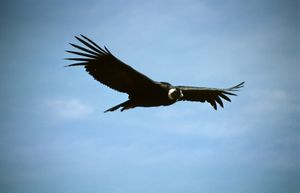Weighing in at an average of 14 kilograms (about 30 pounds), the Andean Condor is the largest known bird with the capability of taking flight. If you are ever in the Andes Mountains, or the neighboring Pacific coasts that border South America, look for the bird’s dark black coloring coupled with white feathers surrounding its neck. And if your color blind, don’t worry about it, because this bird is HUGE. These omnivorous creatures weigh as much as five gallons of water. Their four foot height along with a ten foot wing span threatens many other species located near them. If you ever do come across this species, and think to yourself, “It looks like a condor, but its smaller than the average one”, then you have just come across the female Andean condor. Unlike many other birds, the size of the male condor is much greater than that of the female.
They maintain a carrion diet, meaning they feast on large and medium size animals who are usually already dead. They have a vast option of food because of the distance they cover when they fly.

Curiosity led me to research really how this heavy-set bird took flight. In order to take off from the ground, the condor flaps its wings numerous times. However when it has attained a respectable velocity and elevation, it rarely flaps its wings; it maintains a very smooth flight. When soaring mid-air, the condor lays out its wings horizontally while also pointing its primary feathers upward at the tip (shown in the picture above). To further understand how smooth this bird really flies, watch this video: The Andean Condor Mid-Flight
These birds have been known to fly 7000 meters above sea level, and when doing so, they are constantly looking for prey. When its sees potential food, the condor nosedives at a high velocity towards its target. It makes its first contact with the beak, stabbing the dead prey until it rips off a good enough bite.
The average life span of the Andean Condor is about 50 years. They only mate once a year, and because of these limited reproduction abilities, coupled with less and less food being available to them, the population of this species is on the decline.
References:
http://www.peregrinefund.org/subsites/explore-raptors-2001/vultures/andcondr.html
http://animals.nationalgeographic.com/animals/birds/andean-condor/
http://www.clemetzoo.com/rttw/condor/allabt.htm
http://nationalzoo.si.edu/animals/birds/facts/factsheets/fact-andeancondor.cfm
2 Comments
Lorena Barba posted on October 11, 2011 at 1:17 pm
They must have really good eyesight to spot some food from 7000 meters! That is terribly high … or maybe that just refers to their altitude with respect to sea level, but they are really prowling mountain areas, so their height above ground is not so much?
You know, the condor is featured in the Chilean coat of arms 🙂
Nathan Provencher posted on October 12, 2011 at 5:27 pm
Wow this is a truly amazing sight! Great description Gabriel. It is incredible that any creature could fly at such heights especially with its immense size. Great (and very interesting) post!